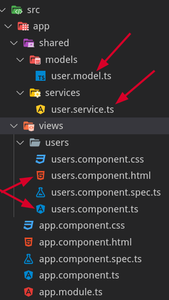Describe the MVC framework in Angular
Last Updated :
26 Mar, 2024
In Angular, when we build websites or web apps with HTML, CSS, and JavaScript, things can get really complicated. Imagine hundreds or even thousands of lines of code, all working together. That’s where frameworks and patterns come in to help us organize our code and make it easier to manage. One popular pattern is called MVC, which stands for Model-View-Controller.
The Model-View-Controller (MVC) framework is an architectural/design pattern that separates an application into three main logical components Model, View, and Controller. Each architectural component is built to handle specific development aspects of an application.
In this article, we will learn about the MVC framework in Angular.
What is MVC?
MVC is like a blueprint for building web applications. It divides our app into three main parts:
The Model-View-Controller (MVC) is not just a framework but an architectural pattern that divides an application into three interconnected components: Model, View, and Controller. Each component serves a distinct purpose, fostering a clear separation of concerns and promoting modular development.
Model:
In Angular, the Model encapsulates data and business logic, providing a centralized source of truth for the application. This can include data retrieved from APIs, user inputs, or application state. Angular services often serve as the backbone of the Model, facilitating data manipulation and sharing across different components.
View:
The View in Angular comprises HTML templates that define the user interface of the application. It represents the presentation layer and is responsible for rendering data from the Model to the user. Views in Angular are dynamic and reactive, seamlessly updating in response to changes in the underlying data.
Controller:
In Angular, the Controller is often represented by components or directives. These act as intermediaries between the View and the Model, facilitating communication and handling user interactions. Controllers in Angular primarily focus on managing data flow and business logic, ensuring that the application responds appropriately to user actions.
Folder Structure in Angular Implementing MVC:

Folder Structure in Angular Implementing MVC
Working of the MVC Framework in Angular:
In Angular, the MVC (Model-View-Controller) framework works seamlessly with the Model representing data and business logic, the View rendering the user interface, and Components acting as Controllers to manage interactions between the Model and View. While Components serve as the ViewModel, Angular’s data binding and dependency injection mechanisms provides easy communication between these components, ensuring efficient data flow and seamless user experience in modern web applications. This flow of data between the components forms the backbone of the MVC architecture in Angular.
Advantages of MVC in Angular:
- Modularity and Maintainability: By providing a clear separation, MVC promotes modularity and maintainability, making it easier to manage and extend Angular applications.
- Testability: The distinct components of MVC provides unit testing that allows you to verify the functionality of each component in isolation, thus ensuring the robustness of the application.
- Code Reusability: MVC supports code reusability, as components can be easily shared across different parts of the application, reducing redundancy and improving efficiency.
- It supports Test Driven Development (TDD).
- It works well for Web apps that are supported by large teams of web designers and developers.
- This architecture helps to test components independently as all classes and objects are independent of each other
Disadvantages of MVC in Angular:
- Learning Curve: For the newbies it may feel them a steep learning curve. However, once mastered, it offers significant benefits in terms of code organization and scalability.
- Increased Complexity: While MVC supports modularity, it may also introduce additional complexity, especially in larger applications. Developers must strike a balance between granularity and simplicity to avoid over-engineering.
- The framework navigation can be complex as it introduces new layers of abstraction which requires users to adapt to the decomposition criteria of MVC.
- Increased complexity and Inefficiency of data.
Conclusion
The MVC framework in Angular serves as a foundation of modern web development, provides a structured approach to building dynamic and maintainable applications. By dividing applications into distinct components – Model, View, and Controller – Angular makes it easier for developers to create reusable and scalable web apps that implements best practices and design principles. While mastering the details of MVC may require time and effort, the benefits it offers in terms of modularity, testability, and code reusability make it a worth insvesting time for any Angular developer.
Share your thoughts in the comments
Please Login to comment...